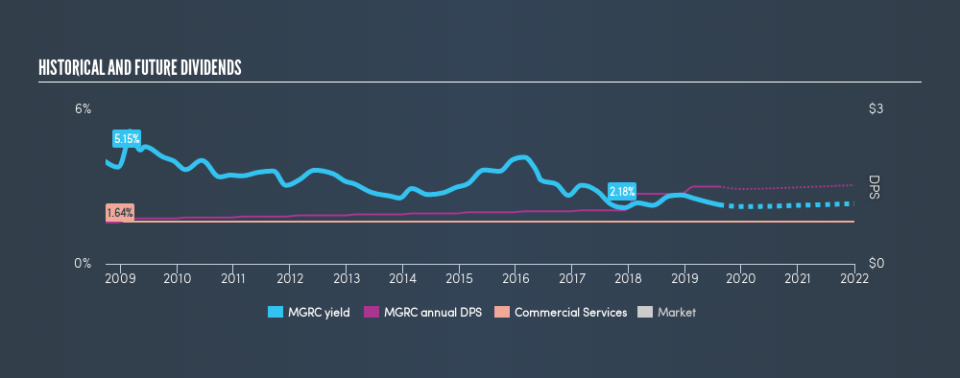Is McGrath RentCorp (NASDAQ:MGRC) A Smart Pick For Income Investors?

Dividend paying stocks like McGrath RentCorp (NASDAQ:MGRC) tend to be popular with investors, and for good reason - some research suggests a significant amount of all stock market returns come from reinvested dividends. Unfortunately, it's common for investors to be enticed in by the seemingly attractive yield, and lose money when the company has to cut its dividend payments.
A 2.3% yield is nothing to get excited about, but investors probably think the long payment history suggests McGrath RentCorp has some staying power. Some simple analysis can reduce the risk of holding McGrath RentCorp for its dividend, and we'll focus on the most important aspects below.
Explore this interactive chart for our latest analysis on McGrath RentCorp!
Payout ratios
Companies (usually) pay dividends out of their earnings. If a company is paying more than it earns, the dividend might have to be cut. Comparing dividend payments to a company's net profit after tax is a simple way of reality-checking whether a dividend is sustainable. In the last year, McGrath RentCorp paid out 40% of its profit as dividends. This is a middling range that strikes a nice balance between paying dividends to shareholders, and retaining enough earnings to invest in future growth. One of the risks is that management reinvests the retained capital poorly instead of paying a higher dividend.
Another important check we do is to see if the free cash flow generated is sufficient to pay the dividend. The company paid out 63% of its free cash flow, which is not bad per se, but does start to limit the amount of cash McGrath RentCorp has available to meet other needs. It's encouraging to see that the dividend is covered by both profit and cash flow. This generally suggests the dividend is sustainable, as long as earnings don't drop precipitously.
Is McGrath RentCorp's Balance Sheet Risky?
As McGrath RentCorp has a meaningful amount of debt, we need to check its balance sheet to see if the company might have debt risks. A rough way to check this is with these two simple ratios: a) net debt divided by EBITDA (earnings before interest, tax, depreciation and amortisation), and b) net interest cover. Net debt to EBITDA is a measure of a company's total debt. Net interest cover measures the ability to meet interest payments. Essentially we check that a) the company does not have too much debt, and b) that it can afford to pay the interest. With net debt of 2.20 times its EBITDA, McGrath RentCorp has a noticeable amount of debt, although if business stays steady, this may not be overly concerning.
Net interest cover can be calculated by dividing earnings before interest and tax (EBIT) by the company's net interest expense. McGrath RentCorp has EBIT of 10.15 times its interest expense, which we think is adequate.
We update our data on McGrath RentCorp every 24 hours, so you can always get our latest analysis of its financial health, here.
Dividend Volatility
Before buying a stock for its income, we want to see if the dividends have been stable in the past, and if the company has a track record of maintaining its dividend. For the purpose of this article, we only scrutinise the last decade of McGrath RentCorp's dividend payments. During this period the dividend has been stable, which could imply the business could have relatively consistent earnings power. During the past ten-year period, the first annual payment was US$0.80 in 2009, compared to US$1.50 last year. This works out to be a compound annual growth rate (CAGR) of approximately 6.5% a year over that time.
Businesses that can grow their dividends at a decent rate and maintain a stable payout can generate substantial wealth for shareholders over the long term.
Dividend Growth Potential
While dividend payments have been relatively reliable, it would also be nice if earnings per share (EPS) were growing, as this is essential to maintaining the dividend's purchasing power over the long term. It's good to see McGrath RentCorp has been growing its earnings per share at 16% a year over the past 5 years. A company paying out less than a quarter of its earnings as dividends, and growing earnings at more than 10% per annum, looks to be right in the cusp of its growth phase. At the right price, we might be interested.
Conclusion
When we look at a dividend stock, we need to form a judgement on whether the dividend will grow, if the company is able to maintain it in a wide range of economic circumstances, and if the dividend payout is sustainable. Firstly, we like that McGrath RentCorp pays out a low fraction of earnings. It pays out a higher percentage of its cashflow, although this is within acceptable bounds. It hasn't demonstrated a strong ability to grow earnings per share, but we like that the dividend payments have been fairly consistent. Overall we think McGrath RentCorp scores well on our analysis. It's not quite perfect, but we'd definitely be keen to take a closer look.
Earnings growth generally bodes well for the future value of company dividend payments. See if the 3 McGrath RentCorp analysts we track are forecasting continued growth with our free report on analyst estimates for the company.
We have also put together a list of global stocks with a market capitalisation above $1bn and yielding more 3%.
We aim to bring you long-term focused research analysis driven by fundamental data. Note that our analysis may not factor in the latest price-sensitive company announcements or qualitative material.
If you spot an error that warrants correction, please contact the editor at editorial-team@simplywallst.com. This article by Simply Wall St is general in nature. It does not constitute a recommendation to buy or sell any stock, and does not take account of your objectives, or your financial situation. Simply Wall St has no position in the stocks mentioned. Thank you for reading.

